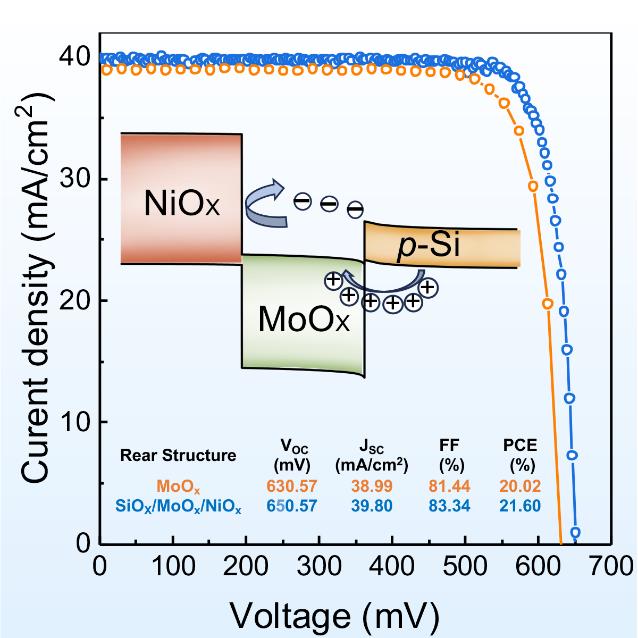Researchers from the Shanghai Advanced Research Institute (SARI) of the Chinese Academy of Sciences have proposed a novel "bilayer" structure composing of different transition metal oxide (TMO) thin films in crystalline silicon (c-Si) solar cells in order to improve the cells' efficiency.
The researchers combined NiOx and MoOx films into a bilayer structure that extracts "hole carriers" from c-Si more efficiently than single-layer films can. The results were published in Cell Reports Physical Science.
"Hole carriers" carry a positive charge. Together with electrons, which have opposite polarity, they were created after c-Si absorbs sun light. By extracting positive holes and negative electrons from c-Si to external circuits, the sun light is converted to usable electricity - this is what a c-Si solar cell does. "Extracting" carriers from c-Si is critical and they can be realized by carrier-selective contacts (CSCs) such as TMO films.
CSCs play an important role in improving the power conversion efficiency (PCE) of c-Si cells. Existing single-layer, thin TMO films such as MoOx or NiOx cannot effectively extract the desired carriers-mainly holes, thus leading to c-Si solar cells with mediocre efficiency.
In a NiOx/MoOx bilayer structure, however, MoOx can induce band bending at the interface, which is favorable for hole carrier extraction. Moreover, NiOx helps to block undesired electron carriers. This is confirmed by both band alignment simulation and minority carrier lifetime measurements.
Taking advantages of these features, the researchers reported a remarkable PCE of 21.31% in c-Si solar cells employing NiOx/MoOx bilayers.
Moreover, forming an additional ultra-thin SiOx layer on the silicon surface can further suppress loss pathways such as recombination, etc.
As a consequence, using an NiOx/SiOx/MoOx structure can further boost the device's PCE to 21.60%. This is the highest reported efficiency of any c-Si solar cell employing MoOx-based hole-selective contacts instead of a costly a-Si:H passivation layer, according to the researchers.
This study highlights a promising and robust approach to employing bilayers as efficient structures for extracting hole carriers. It serves as an inspiring guide for tackling challenges in the field of passivating contact c-Si solar cells.
This work was supported by the National Natural Science Foundation of China, the Natural Science Foundation of Shanghai, and the Shanxi Science and Technology Department, among others.







